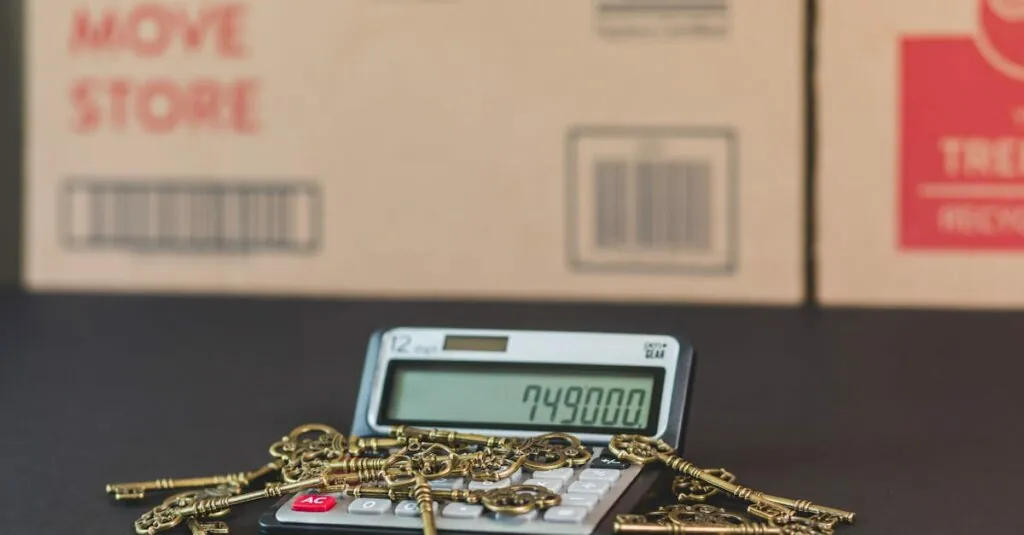Moving can feel like a whirlwind of chaos, excitement, and the ever-looming threat of overspending. Picture this: you’re knee-deep in cardboard boxes, trying to remember if you packed the coffee maker or if it’s still sitting in the kitchen, mocking you. Amidst the madness, creating a moving budget is your secret weapon for keeping both your sanity and your wallet intact.
Table of Contents
ToggleUnderstanding the Importance of Creating a Moving Budget
Creating a moving budget plays a critical role in the relocation process. Budgeting helps individuals and families identify their overall expenses, ensuring they account for each financial aspect of the move. Financial clarity reduces the stress often associated with unexpected costs.
Many moving costs appear during the planning phase. Anticipated expenses include hiring movers, renting trucks, purchasing packing supplies, and utility setup fees. Each cost presents an opportunity to make informed decisions. Inaccurate estimations can lead to overspending, creating financial strain.
A moving budget encourages prioritization. With a detailed list of essential expenses, movers can allocate funds effectively. Essential items might include transportation, storage, and packing resources. Non-essential expenses like new furniture can wait, allowing for adjustments when needed.
Tracking expenditures is vital once moving starts. By tracking every expense, individuals maintain control and can quickly identify areas for cuts if necessary. This approach helps avoid financial pitfalls that often accompany relocation.
Lastly, a well-structured moving budget contributes to long-term financial health. Responsible spending during a move lays the groundwork for future budgetary practices. Establishing this habit encourages smart financial planning in other areas of life, making transitions smoother.
Key Components of a Moving Budget
Creating a comprehensive moving budget involves multiple components that ensure clarity and control over expenses. Focusing on estimated costs plays a significant role in budgeting effectively.
Estimating Moving Expenses
Estimating moving expenses requires looking at various cost factors. These factors often include hiring professional movers, which can range from $300 to $2,000 depending on distance and service level. Renting a truck also contributes to the overall budget, with averages between $20 and $200 per day. Packing supplies, such as boxes and tape, typically range from $50 to $150 for an average household. Evaluating each of these expenses helps form a clearer picture, ensuring individuals do not overlook any crucial costs.
Planning for Unforeseen Costs
Planning for unforeseen costs is essential to maintaining financial stability during a move. Setting aside at least 10 to 15 percent of the total moving budget can address unexpected expenses like last-minute fees or additional packing supplies. Having this financial cushion reduces stress and allows for flexibility in the face of surprises. Situations such as unexpected delays or repairs might arise, impacting the overall budget. By incorporating these potential costs, individuals can enjoy a smoother transition and stay within their financial limits.
Tips for Creating a Moving Budget
Creating a comprehensive moving budget involves utilizing effective tools and resources alongside setting achievable goals.
Tools and Resources
Utilize budgeting apps to track expenses in real-time. Many apps allow users to input costs, categorize expenses, and monitor spending against the budget. Consider spreadsheets for a flexible and detailed breakdown of every financial aspect. Online tools often provide cost calculators for services such as truck rentals and moving companies. Research current prices in the area to ensure accurate estimations. Leverage community forums for insights on potential savings or recommended services. Consult moving checklists found on reputable websites to cover all necessary aspects.
Setting Realistic Goals
Set achievable financial targets based on a thorough evaluation of anticipated expenses. Prioritize essential costs like hiring movers, renting trucks, and purchasing packing supplies before less critical expenditures. Allocate funds for additional expenses, including utility deposits and insurance fees, to ensure coverage. Establish a timeline for when to finalize each component of the budget, keeping flexibility in mind for unexpected expenses. Review past moves for historical insights on challenges faced and budgets overshot. Adjust expectations to reflect current financial circumstances, reducing stress and enhancing overall planning effectiveness.
Adjusting Your Budget as Needed
Flexibility is crucial when adjusting a moving budget. Costs may change unexpectedly, making it necessary to reassess initial estimates. Whenever new expenses arise, individuals should immediately update their budgets to maintain accuracy. For example, if hiring a moving company incurs additional charges, those amounts must reflect in the budget.
Tracking expenses in real-time aids in effective adjustments. Using budgeting apps can streamline this process, allowing individuals to see their spending habits clearly. Individuals should dedicate time each week to review costs and compare them against the projected budget. This practice helps identify not only overspending but also areas where savings can occur.
Setting aside a contingency fund of 10 to 15 percent of the total budget serves as a safeguard. This financial cushion buffers against surprises like increased travel costs or last-minute supply purchases. If emergencies arise, accessing these funds can relieve stress.
Prioritizing essential costs throughout this adjustment process is vital. Individuals should differentiate between must-have items and nice-to-have items. By focusing on necessary expenses first, they can ensure that critical components of the move are covered even in a tightened budget.
Moreover, revisiting past moves provides valuable insights for budget adjustments. Learning from previous experiences can lead to more accurate cost predictions. Individuals might find specific areas where they consistently overspend and can allocate resources more effectively.
Regularly communicating with all parties involved in the move also aids budget adjustments. Sharing updates on budget constraints with moving companies or family members helps manage expectations and encourages cooperation. Adaptability becomes an integral part of the moving budgeting process, paving the way for financial control amidst the chaos of relocation.
Conclusion
Creating a moving budget is essential for a successful relocation. It not only helps manage finances but also alleviates stress during a chaotic time. By thoroughly estimating costs and tracking expenses, individuals can avoid overspending and stay within their financial limits.
Flexibility is key; adjusting the budget as needed ensures that unexpected expenses don’t derail the entire moving process. Utilizing budgeting tools and resources can enhance clarity and efficiency. Ultimately, a well-planned moving budget fosters responsible spending habits and contributes to long-term financial health, making the transition smoother and more manageable.





